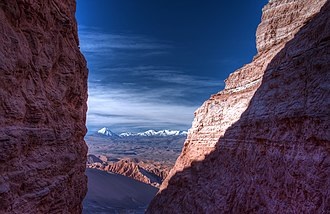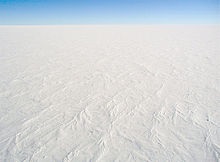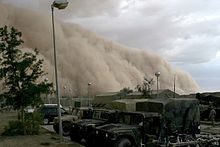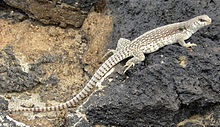|
|
| |
|
|
| |
|
|
|
|
| |
 |
| Valle de la Luna
("Valley of the Moon") in the Atacama Desert of
Chile, the world's driest non-polar desert. |
Deserts
A desert is an arid (very dry) biome. They get less than
25 cm (9.8 inches) of rainfall a year. Another source
defines it as "any region that can have a moisture
deficit over the course of a year. In other words, they
can have less rainfall in a year than they give up
through evaporation".
These kinds of areas can cover about 33% of the land on
Earth. That includes much of Antarctica, where large
areas get no snow at all. The largest hot desert is the
Sahara desert, in northern Africa, covering 9 million
square kilometers.
Deserts land surfaces are various – examples are stones,
sand dunes and snow. They have a wide variety of animals
and plants. Deserts sometimes expand (desertification),
and sometimes contract.
Deserts are mostly found in the western part of the
Americas, Western Asia, Central Australia, and South and
North Africa. Many, such as the Sahara (the largest),
are very hot during the day and have cold nights, but
there are also cold deserts such as the Atacama in South
America which remain frozen day and night. |
|
 |
| Cold desert: snow
surface at Dome C Station, Antarctica. |
Cold deserts
There are hot deserts and cold deserts. Cold deserts may
be covered with snow or ice but some are so dry that the
ice sublimates away. Some cold deserts have a short
season of above-freezing temperatures. These deserts are
called tundra. An ice cap can be a cold desert that
remains below freezing all year-round.
Cold deserts can be found close to the poles. That is
why they are also called polar deserts. Other regions of
the world have cold deserts too, for instance high
altitude areas like the Himalayas. These are called
montane deserts. Antarctica is the world's largest cold
desert. |
 |
| The Sahara is the
largest hot desert in the world. |
Hot deserts
Hot deserts are mostly in the subtropics. They can be
covered by sand, rock, salt lakes, stony hills and even
mountains. Most non-polar deserts are hot in the day and
chilly at night. The temperature in the daytime can
reach 50 °C (122 °F) or higher in the summer, and dip to
0 °C (32 °F) or lower at night time in the winter.
The largest hot desert in the world is the Sahara in
North Africa. It is almost as large as Europe or the
United States. The Sahara desert is also the hottest
desert in the world.
The driest desert in the world is the Atacama Desert in
South America. The Atacama Desert had no rain for 401
years, between 1570 and 1971. This desert is caused by a
cold ocean current. |
|
 |
| The Agasthiyamalai
hills cut off Tirunelveli in India from the
monsoons, creating a rainshadow region. |
Rain
It does rain in the desert, but not often. One place in
the Atacama Desert had no rain for 401 years. In other
deserts it may rain every year or once every few years.
Rains in a desert may bring a great amount of water to
the ground in a short time. Some rain passes straight
into the dry soil, but the rest may form a temporary
river. Wadis, stream channels that are normally dry, can
quickly fill after heavy rain, causing a flash flood.
People sometimes bring water from wet places to hot
deserts so plants can grow. This is called irrigation. |
 |
| Dust storm about to
engulf a military camp in Iraq, 2005. |
Sandstorm
A sandstorm or dust storm arises when wind blows loose
sand and dust from a dry surface. Clouds of sand or dust
are often so dense that they obscure the sun. A
sandstorm can move whole sand dunes. Sandstorms are
common in large, dusty deserts.
Sand and dust storms are natural events that occur in
arid regions where the land is not protected by a
covering of vegetation. Dust storms usually start in
desert margins rather than the deserts themselves where
the finer materials have already been blown away. As a
steady wind begins to blow, fine particles lying on the
exposed ground begin to vibrate. At greater wind speeds,
some particles are lifted into the air stream. When they
land, they strike other particles which may be jerked
into the air in their turn, starting a chain reaction.
Once ejected, these particles move in one of three
possible ways, depending on their size, shape and
density; suspension, saltation or creep. |
|
 |
| The desert iguana (Dipsosaurus
dorsalis) is well-adapted to desert life. |
Animals and plants
There are not many animals in the desert, but some
animals are able to survive. They have different ways to
survive the intense conditions of the desert. Examples
of animals that live in hot deserts are lizards, small
rodents, snakes, and camels. Plants and animals in hot
deserts must live with very little water.
Xerophytic plants which live in the desert have special
adaptations. They may survive by growing roots that are
very near the surface to absorb the rain that may fall
before it evaporates. Plants such as the cactus have
thick, fleshy stems that help them store water.
Small animals such as lizards and small rodents often
escape the hot rays by digging underground burrows where
they live. They only come out at night to search for
food. Like the plants, desert animals must live on as
little water as possible. Most of the water used by
these animals comes from seeds and stems that absorb and
hold water. Camels survive in hot deserts by storing
water in body fat in their humps. Like other desert
animals, the camel loses little water in its wastes
(urine and feces). |
|
|
 Kiddle: Deserts Kiddle: Deserts
Wikipedia: Deserts |
|
|
|
|
|
|
|
|
|
|
|
|
|
|
|
|
|
|
Search Fun Easy English |
|
|
|
|
|
|
|
|
|
|
|
|
|
|
|
About
Contact
Copyright
Resources
Site Map |